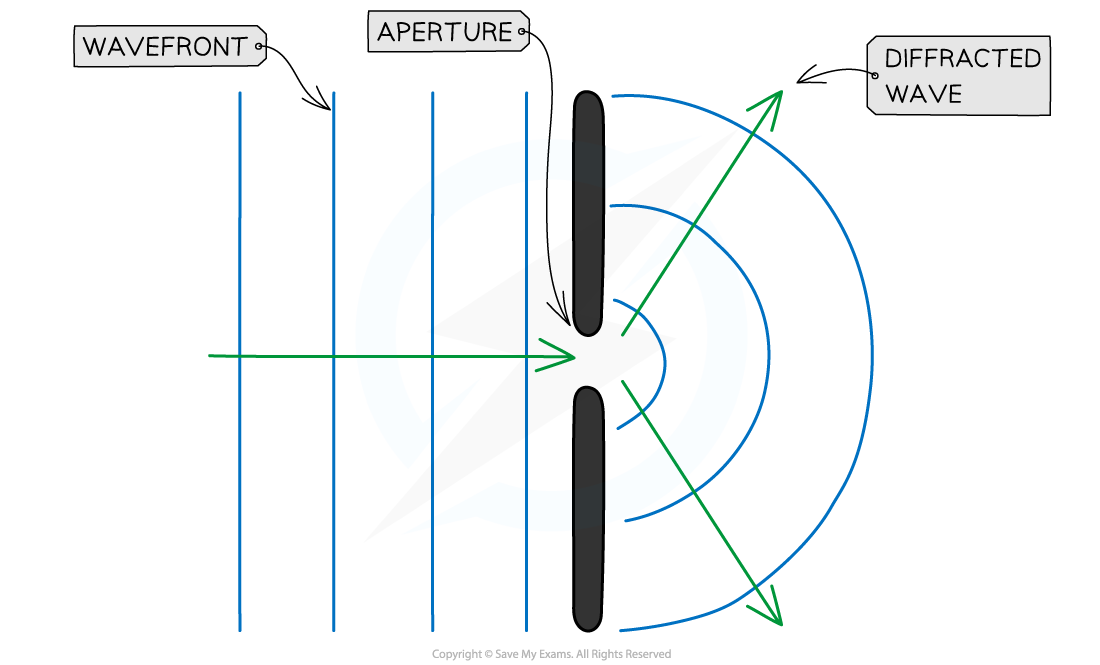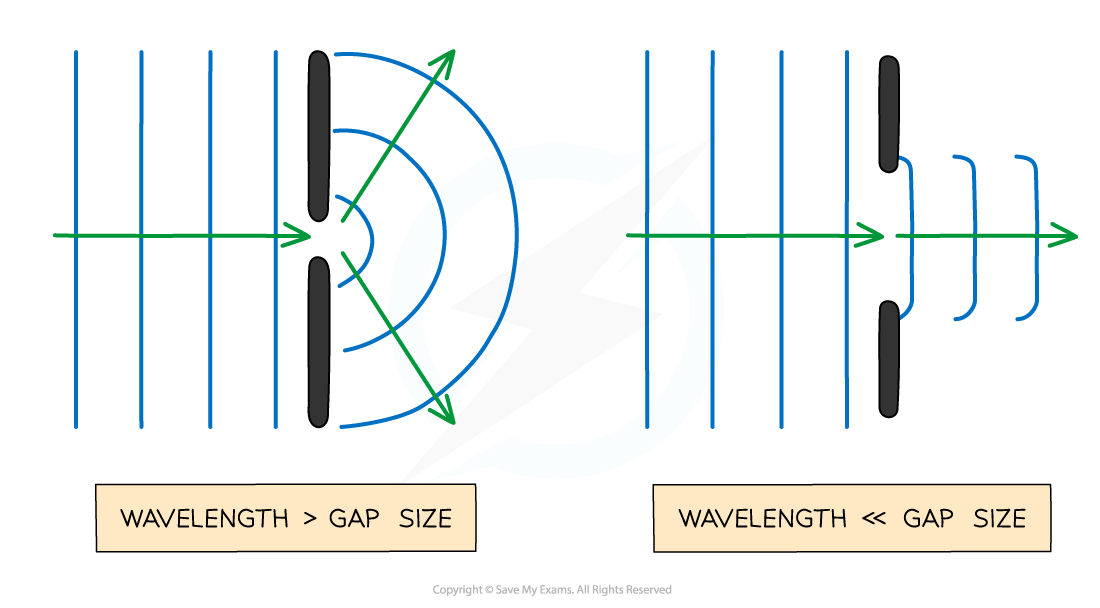Diffraction of Waves (DP IB Physics) : Revision Note
Diffraction of Waves
Diffraction is defined as:
The spreading out of waves after they pass through a narrow gap or around an obstruction
Diffraction can occur when waves:
pass through an aperture
pass around a barrier

Water waves diffract through a gap in a barrier such as in a harbour
Diffraction through an aperture
When a wave passes through a gap or aperture:
The waves spread out so they have curvature
The amplitude of the wave is less because the barrier on either side of the gap absorbs wave energy

Diffraction causes waves to spread out and become curved after passing through a narrow gap
When the wavelength of the wave and the width of the gap is similar then diffraction occurs:
When the wavelength is bigger than the gap then more diffraction occurs, so the wave spreads out more after passing through
When the wavelength is smaller than the gap then less diffraction occurs, so the wave spreads out less after passing through
When the wavelength of the wave and the width of the gap are not similar then diffraction does not occur:
For gaps that are much smaller than the wavelength of the wave, the wave passes over the gap easily so no diffraction occurs
For gaps that are much bigger than the wavelength of the wave, the majority of the wave passes straight through the gap so no diffraction occurs
As the gap size increases, compared to the wavelength, the amount of curvature on the waves gets less pronounced
Effect of aperture size on diffraction

The size of the gap (compared to the wavelength) affects how much the waves spread out when diffracted through a gap
Diffraction around a barrier
Diffraction can also occur when waves curve around an edge or barrier
The waves spread out to fill the gap behind the object
The extent of this diffraction also depends upon the wavelength of the waves
The greater the wavelength then the greater the diffraction

When a wave goes past the edge of a barrier, the waves can curve around it. Shorter wavelengths undergo less diffraction than longer wavelengths
When the barrier is larger than the wavelength:
There is some diffraction around the barrier
A lot of incident waves are reflected back towards the source
There is a "shadow" region behind the barrier where no wavefronts are present
When the barrier is the same size as the wavelength:
There is more diffraction around the barrier
There is a smaller "shadow" region behind the barrier where no wavefronts are present
When the barrier is smaller than the wavelength:
No diffraction occurs around the barrier
The "shadow" region behind the barrier is very small

The size of the barrier in relation to the wavelength affects how the waves diffract around it
Worked Example
When a wave is travelling through the air, which scenario best demonstrates diffraction?
A. UV radiation through a gate post
B. Sound waves passing a diffraction grating
C. Radio waves passing between human hair
D. X-rays passing through atoms in a crystalline solid
Answer: D
Diffraction is most prominent when the wavelength is close to the aperture size
Consider option A:
UV waves have a wavelength between (4 × 10–7) and (1 × 10–8) m so would not be diffracted by a gate post
Radio waves, microwaves or sound waves would be more likely to be diffracted at this scale
Consider option B:
Sound waves have a wavelength of (1.72 × 10–2) to 17 m so would not be diffracted by the diffraction grating
Infrared, light and ultraviolet waves would be more likely to be diffracted at this scale
Consider option C:
Radio waves have a wavelength of 0.1 to 106 m so would not be diffracted by human hair
Infrared, light and ultraviolet waves would be more likely to be diffracted at this scale
Consider option D:
X-rays have a wavelength of (1 × 10–8) to (4 × 10–13) m
This is a suitable estimate for the size of the gap between atoms in a crystalline solid
Hence X-rays could be diffracted by a crystalline solid
Therefore, the correct answer is D
Worked Example
An electric guitar student is practising in his room. He has not completely shut the door of his room, and there is a gap of about 10 cm between the door and the door frame.
Determine the frequencies of sound that are best diffracted through the gap.
The speed of sound can be taken to be 340 m s–1
Answer:
Step 1: Optimal diffraction happens when the wavelength of the waves is comparable to (or larger than) the size of the gap
λ = 10 cm = 0.1 m
Step 2: Write down the wave equation
Where speed of sound, v = 340 m s–1
Step 3: Rearrange the above equation for the frequency f
Step 4: Substitute the numbers into the above equation
The frequencies of sound that are best diffracted through the gap are:
f ≤ 3400 Hz
Examiner Tips and Tricks
When drawing diffracted waves, take care to keep the wavelength (the distance between each wavefront) constant.

You've read 0 of your 5 free revision notes this week
Sign up now. It’s free!
Did this page help you?
